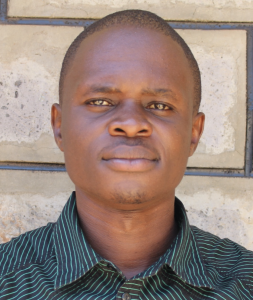While seated on a bus, Field Officer Samuel Simidi received a strange call from an unknown number. Answering it, he was pleasantly surprised to learn it was a local community member requesting help in protecting his community's water source. Our team decided to pay a visit the following day to Kimarani to assess the viability of Kipsiro Spring for protection. When we arrived, we were received by none other than Mr. Mark Kipsiro, the community member who made the call and the landowner of Kipsiro Spring.
Upon arrival at the water point, we were happy to see the spring discharging at a high rate. It took only 55 seconds to fill a 20-liter jerrycan - a good thing when there are 200 people depending on this spring for their daily water needs. Kipsiro Spring is situated on a slope, so community members have improvised stairs in the earth to help traverse the path. The discharge channel has been fitted with an improvised pipe of sorts, using the backs of banana plants to help direct water into people's jerrycans.
In its unprotected state, Kipsiro Spring is open to all types of contamination including animal waste, dirt and mud, bugs, and human contamination. With the improvised discharge pipe so low to the ground, debris often falls into the waterflow.
When it rains, these problems only grow.
"This water point is a permanent water source and it has been in existence for decades now," said Paul Sigor, a 55-year-old community member who works as a teacher and relies on Kipsiro Spring for water.
"We have had cases of diarrhea, typhoid, and other water-related diseases and this is because our water source is exposed to contaminants. Any interventions will be highly welcomed and appreciated," he said.
Kimaran is inhabited by the Tiriki, a sub-tribe of the Luhyia. The community has a rural set-up with a majority of the members practicing small scale farming due to the unavailability of land. They grow maize, beans, sweet potatoes, and indigenous vegetables and any surplus is sold in the nearby market just to earn a few coins. A majority of the houses have roofs made of iron sheets, and their walls vary from mud to concrete.
Being a rural set-up, a majority of the community members are the elderly and the children as most of the youths are out in major towns working. A majority of the children are left with their grandparents who take good care of them, even helping them through their studies.
For Mark Kipsiro, the landowner for the area where Kipsiro Spring is located, protecting this spring would mean so much more than bringing clean water to his community. For a long time now, community members have been drawing water from the unprotected spring and this has put their precious lives in danger. Mark described his average day:
"I wake up at 6:00 am, prepare myself for 20 minutes then immediately tend to my chickens and my small farm. At 7:30 am, I get back to the house to carry out the house chores then later open my small kiosk which I run almost the entire day. I retire at 8:00 pm"
When Mark or anyone else gets sick from the spring water, they are prevented from doing their farm work or running their small businesses, thus they are not earning money for their family. On top of that, they are spending the money they have saved on expensive medicines and treatment for their waterborne illnesses.
Kimarani community members are trying very hard to live to the highest hygiene standards required for a healthy life, but this has not been achieved 100%. A walk through various homesteads showed us all or almost all of the sanitation facilities needed in a homestead such as a bathing room, dishrack, and clotheslines, but the challenge lies with hygiene.
Without clean water to assist in cleaning or washing hands, especially around latrines, the community is forced to leave their health to chance.
"We are not much behind in regard to our hygiene and sanitation standards," explained Mark.
"We [are] having just a few loopholes here and there that we need to fix as a community in order to achieve the standards required [for a healthy life]. Your help will be appreciated in order to achieve all these requirements."
What we can do:
Spring Protection
Protecting the spring will help provide access to cleaner and safer water. Construction will keep surface runoff and other contaminants out of the water. With the community’s high involvement in the process, there should be a good sense of responsibility and ownership for the new clean water source.
Fetching water is a task predominantly carried out by women and young girls. Protecting the spring and offering training and support will, therefore, help empower the female members of the community by freeing up more of their time and energy to engage and invest in income-generating activities.
Training
Community members will attend hygiene and sanitation training for at least 2 days. This training will ensure participants have the knowledge they need about healthy practices and their importance. The facilitator plans to use Participatory Hygiene and Sanitation Transformation (PHAST), Community-Led Total Sanitation (CLTS), Asset-Based Community Development (ABCD), group discussions, handouts, and demonstrations at the spring. One of the most important topics we plan to cover is the handling, storage, and treatment of water. Having a clean water source will be extremely helpful, but it is useless if water gets contaminated by the time it is consumed. We will also emphasize the importance of handwashing.
Training will result in the formation of a committee that will oversee the operations and maintenance of the spring. They will enforce proper behavior around the spring and delegate tasks that will help preserve the site, such as building a fence and digging proper drainage channels. The fence will keep out destructive animals, and the drainage will keep the area’s mosquito population at a minimum.
Sanitation Platforms
At the end of training, participants will select 5 families that should benefit from new concrete latrine floors. Training will inform the community and selected families on what they need to contribute to make this project a success. They must mobilize locally available materials, including bricks, clean sand, and gravel. The 5 families chosen for sanitation platforms must prepare by sinking a pit for the sanitation platforms to be placed over. All community members must work together to make sure that accommodations and food are always provided for the work teams.

 Protected Spring
Protected Spring
 Rehabilitation Project
Rehabilitation Project








































